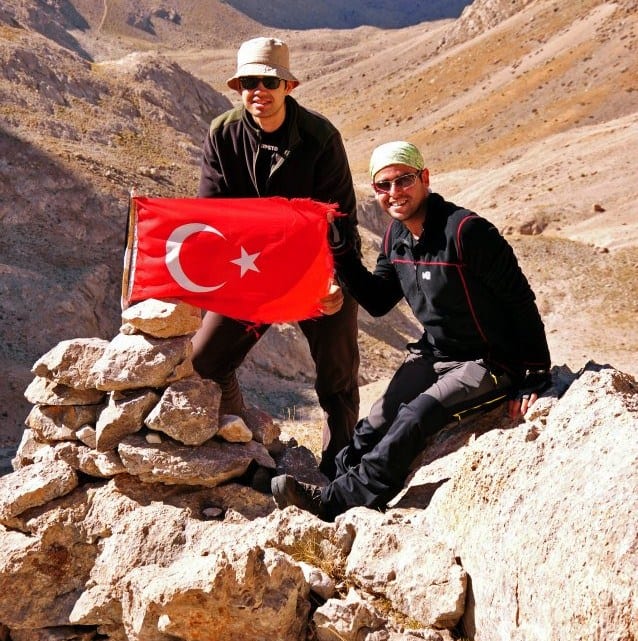By Gökay Ürk, guest writer for Yabangee

Mountaineering is probably the best outdoor sport for adrenalin junkies, and Turkey’s impressive range of mountains have enabled this sport to become increasingly popular among Turkish and foreign climbers in the last two decades.
Ağrı Dağı (Mount Ararat), Aladağlar, Uludağ, Kayseri Erciyesdağı, and Hasan Dağı are a few of the most prominent mountains surrounding Turkey. Perhaps the most famous of all is Mount Ararat, at 5137 meters, which attracts many climbers and tourists. According to legend, it’s where Noah’s ark came to rest after the flood.
Sent by the German government to lead a scientific research mission, Physics Professor F. V. Parrot was the first person to successfully climb Büyük Ağrı Dağı, 5165 meters, in the history of Turkish mountaineering on 27 September, 1829. Prof. Parrot’s climb is widely recognized as marking the start of climbing as an outdoor activity in Turkey. After the death of Prof. Parrot in 1844, Prof. O. W. Herman Abich and his colleague Dr. Wagner, again acting for the German government, performed second climbs to Büyük Ağrı Dağı in 1845. These two successful climbing experiences resonated in the European media, and more researchers wanted to explore Turkish mountains. In order to conduct scientific research, the Austrian geologist Franz Schaffer climbed to the summit of Alaca Başı at Aladağlar in 1901. His climbing notes awakened the curiosity of professional climbers, and more German climbers scaled to the same summit. AS time went on, more and more mountaineers came to Turkey to climb its mountains.
It is interesting to note that Ali Vehbi Türküstün, defined as the first Turkish Mountaineer, performed his first climb to the highest point of Swiss Alps, Mont Blanc, in 1906, rather than any mountain in Turkey. Turks’ interest in mountaineering stems from military purposes. In order to gain a stronghold in mountainous areas, Ottoman Superiors established special forces, able to move in such areas quickly. Colonel Cemil Cahit Toydemir and his soldiers climbed Erciyes mountain, at 3916 meters, in 1924. After having successfully completed their climb, Colonel Toydemir wrote the names of all his fellow climbers and put it in a box, which is claimed to bethe first summit notebook in the history of Turkish mountaineering.
As a result of these activities, the first official Turkish mountaineering body – the Turkish Mountaineering Association – was set up in 1928. Following that, the first Turkish mountaineering club was founded in 1933. A federation, including mountaineering and skiing, was established in 1936, but only in 1939 did the Mountaineering Federation officially gain government recognition. Today, Alattin Karaca executes the presidency of the Mountaineering Federation. Considered to be a milestone in the history of Turkish mountaineering, Bozkurt Ergör and Sönmez Targan’s climbs to the summit of Aladağlar, Demizrkazık, in the winter of 1969 encouraged many other climbers to try technical climbing in the winter season.
By the early 1980s, mountaineering gained increasing popularity and respect in Turkey, leading a number of devotees to register private and university mountaineering clubs. This also meant the sport became more popular. The strong cooperation between the Turkish Mountaineering Federation, which is a member of the International Mountaineering and Climbing Federation, and smaller clubs encouraged more and more climbers to try challenging climbs.
Ali Nasuh Mahruki and Tunç Fındık are the two relentless thrill seekers who have played a key role in the sport in Turkey. Nasuh Mahruki’s interest in climbing began in his college years, when he was a business student at Bilkent University in Ankara. After having successfully completed five 7000-meter peaks in Russia, he was awarded the prestigious title of ‘Snow Leopard’ by the Russian Mountaineering Federation. In May 1995, he became the first Turkish and Muslim climber in the world to climb Mount Everest. He also climbed the 8848-meter high K2, one of the most challenging summits in the world, without an oxygen mask. In 1996, Mahruki and his mountaineering friends founded AKUT, a research and rescue team, and they saved many people’s lives in 1999’s tragic Marmara earthquake. They also participated in earthquake research and rescue activities in Greece and India. Today, AKUT is widely regarded as the most trusted Turkish organization, even surpassing the Turkish Army. In 2009, Nasuh Mahruki was awarded the International Gusi Peace Award for his contributions in fostering world peace.
Holding a degree in English Literature from Bilkent University, Tunç Fındık can be defined as the Reinhold Messner of Turkey based on his successful climbs. Fındık has already climbed more than 300 summits all around the world, and with his ’14 x 8000′ project he is aiming to be one of the very few people in the world who have succeeded in climbing the 14 highest mountains above 8000 meters. Besides this project, Tunç Fındık is a professional guide, organizing 3-week long trekking tours to Everest base camp. He is a role model for Turkish youth, organizing motivational speeches, and has written several books. Like Nasuh Mahruki, his success is very important because it inspires the Turkish youth, and makes the unimaginable possible.









Gökay tebrik ederim…profesyonel dağcı olmana az kalmış gibi…
good job! 😉 congritulations.
Really interesting stuff – thanks for sharing.
Başarılarının devamını diler, yüreğinin coştuğu yere akmanı dilerim…
I want to go there…
mukaddes akbulut